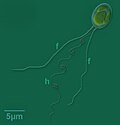Phycodnaviridae is a family of large (100–560 kb) double-stranded DNA viruses that infect marine or freshwater eukaryotic algae. Viruses within this family...
80 KB (9,384 words) - 23:48, 9 November 2024
Nucleocytoviricota (section Phycodnaviridae)
Allomimiviridae Mesomimiviridae Mimiviridae Schizomimiviridae Order Algavirales Phycodnaviridae (Pandoraviridae?) — by phylogeny Unassigned Order Mamonoviridae Class...
28 KB (3,064 words) - 10:51, 15 November 2024
Chlorovirus (category Phycodnaviridae)
virus, is a genus of giant double-stranded DNA viruses, in the family Phycodnaviridae. This genus is found globally in freshwater environments where freshwater...
30 KB (3,491 words) - 19:10, 14 January 2025
viruses: the African swine fever virus (Asfarviridae), Chlorella viruses (Phycodnaviridae) and poxviruses (Poxviridae). The mutation rate in poxvirus genomes...
29 KB (3,273 words) - 08:23, 11 December 2024
into several families: Mimiviridae, Pithoviridae, Pandoraviridae, Phycodnaviridae, and the Mollivirus genus. Some viruses that infect Archaea have complex...
154 KB (18,258 words) - 13:36, 12 January 2025
Coccolithovirus (category Phycodnaviridae)
Coccolithovirus is a genus of giant double-stranded DNA virus, in the family Phycodnaviridae. Algae, specifically Emiliania huxleyi, a species of coccolithophore...
13 KB (1,717 words) - 14:40, 14 August 2023
first giant viruses to be described were chloroviruses of the family Phycodnaviridae. These were discovered in 1981 by Russel H. Meints, James L. Van Etten...
22 KB (2,169 words) - 18:47, 5 December 2024
phycodnaviruses, which in fact may rather belong to Mimiviridae than to Phycodnaviridae. The genome is double-stranded DNA and is 26,421 base pairs in length...
3 KB (253 words) - 22:28, 17 January 2024
virus. The sole species was originally thought to belong to the family Phycodnaviridae. DNA studies have shown that the genus belongs in the family Asfarviridae...
3 KB (298 words) - 04:16, 19 August 2023
papillomavirus 16 dsDNA E protein Phycodnaviridae Paramecium bursaria chlorella virus 1 dsDNA Kcv protein Phycodnaviridae Acanthocystis turfacea chlorella...
20 KB (1,967 words) - 00:33, 29 November 2023
Mimiviridae is the sole recognized member of order Imitervirales. Phycodnaviridae and Pandoraviridae of Algavirales are sister groups of Mimiviridae...
21 KB (2,195 words) - 02:27, 27 June 2024
Algavirales Phycodnaviridae Imitervirales Mimiviridae Pimascovirales Ascoviridae Iridoviridae Marseilleviridae...
47 KB (5,686 words) - 15:20, 8 January 2025
highly diverse. Marine algae can be infected by viruses in the family Phycodnaviridae. These are large (100–560 kb) double-stranded DNA viruses with icosahedral...
91 KB (9,422 words) - 02:56, 15 January 2025
an extended family Mimiviridae (aka Megaviridae) than of the family Phycodnaviridae. "'Virus-eater' discovered in Antarctic lake". Nature News. 28 March...
6 KB (380 words) - 00:46, 15 June 2022
isolated and characterized. It was then believed to belong to the phycodnaviridae along with all other known algae infecting viruses. The discovery of...
7 KB (700 words) - 16:33, 5 July 2024
Paulinoviridae Peribunyaviridae Permutotetraviridae Phasmaviridae Phenuiviridae Phycodnaviridae Picobirnaviridae Picornaviridae Plasmaviridae Plectroviridae Pleolipoviridae...
11 KB (479 words) - 16:28, 7 November 2024
Prasinovirus (category Phycodnaviridae)
Prasinovirus is a genus of large double-stranded DNA viruses, in the family Phycodnaviridae that infect phytoplankton in the Prasinophyceae. There are three groups...
4 KB (309 words) - 23:54, 3 December 2023
double-stranded DNA viruses belonging to the genus Prasinovirus in the family Phycodnaviridae, as well as a Reovirus. It has been estimated that from 2 to 10% of...
21 KB (1,790 words) - 20:25, 8 January 2025
Prymnesiovirus (category Phycodnaviridae)
Prymnesiovirus is a genus of viruses, in the family Phycodnaviridae. Alga serve as natural hosts. There is only one species in this genus: Chrysochromulina...
3 KB (175 words) - 08:57, 12 July 2024
algae-infecting viruses This is especially true for the dsDNA virus family, Phycodnaviridae. However, other groups of dsDNA viruses including giant viruses belonging...
28 KB (3,053 words) - 13:21, 3 September 2024
particular eukaryotic algae, can be found in members of the family phycodnaviridae, a diverse family of large icosahedral viruses with clear importance...
46 KB (4,793 words) - 04:13, 2 December 2024
Algavirales Phycodnaviridae Imitervirales Mimiviridae Pimascovirales Ascoviridae Iridoviridae Marseilleviridae...
15 KB (1,427 words) - 02:39, 31 December 2024
number of marine non-tailed dsDNA viruses. Algal viruses of the family Phycodnaviridae play an important role in controlling algal blooms as well as, with...
30 KB (3,802 words) - 02:33, 11 December 2024
Phaeovirus (category Phycodnaviridae)
Phaeovirus is a genus of viruses, in the family Phycodnaviridae. Alga serve as natural hosts. There are nine species in this genus. The genus contains...
3 KB (164 words) - 12:32, 30 January 2023
Acanthocystis turfacea chlorella virus 1 (category Phycodnaviridae)
Nucleocytoviricota Class: Megaviricetes Order: Algavirales Family: Phycodnaviridae Genus: Chlorovirus Species: Acanthocystis turfacea chlorella virus...
4 KB (393 words) - 17:42, 7 October 2023
Algavirales Phycodnaviridae Imitervirales Mimiviridae Pimascovirales Ascoviridae Iridoviridae Marseilleviridae...
5 KB (468 words) - 03:28, 21 January 2025
Raphidovirus (category Phycodnaviridae)
(likely misspelled Rhaphidovirus) is a genus of viruses, in the family Phycodnaviridae. Alga serve as natural hosts. There is only one species in this genus:...
2 KB (128 words) - 12:33, 30 January 2023
485kb. It is a member of the Megavirales order with characteristics of phycodnaviridae and mimivirus families. Concentrations of Chrysochromulina Lake Ontario...
15 KB (1,613 words) - 17:18, 27 April 2024
the most abundant across all three brine pools. Low abundances of Phycodnaviridae and trace amounts of Iridoviridae are also present within the brine-seawater...
42 KB (4,426 words) - 17:47, 19 December 2024
(120-240 kp), Iridoviridae (140-303 bp), Poxviridae (130–375 kb), Phycodnaviridae (100–560 kb) and Mimiviridae (1200 kb). Hytrosaviruses encode homologs...
31 KB (3,667 words) - 23:39, 21 November 2024















